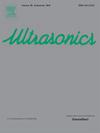Zero group velocity mode nonlinear ultrasonics for fatigue crack detection
IF 3.8
2区 物理与天体物理
Q1 ACOUSTICS
引用次数: 0
Abstract
This short communication reports an enhanced nonlinear ultrasonics methodology leveraging zero group velocity (ZGV) modes for fatigue crack detection. Conventional nonlinear ultrasonics has been widely investigated as a promising tool for monitoring incipient damage due to its high sensitivity. Nevertheless, nonlinear features are vulnerable and could be easily covered by other nonlinearity sources from electronic instruments, actuator bonding layers, and distributed material nonlinearity. To address such challenges, this short communication exploits the ZGV mode to amplify the second harmonic signal features at fatigue cracks. ZGV modes are endowed with unique characteristics of a zero-value group velocity with a finite wavenumber, introducing a localized resonance and confining the wave energy in the vicinity of a fatigue crack, which will greatly enhance the signal nonlinear features. This short communication develops as follows: firstly, theoretical fundamentals of ZGV Lamb modes are laid out for preparing the investigation. Then, the half-ZGV frequency is selected for wave actuation, targeting at generating the second harmonic at the ZGV resonance. Finite element simulations demonstrate that the half-ZGV frequency actuation triggers the ZGV resonance at the fatigue crack, thus considerably enhancing the second harmonic features compared to the standard actuation. Furthermore, the superb caliber of such a method is further demonstrated by several peculiar characteristics of the nonlinear ZGV generation from temporal, spectral, and spatial perspectives. This communication finishes with concluding remarks and suggestions for future work.
零群速度模式非线性超声疲劳裂纹检测
这篇简短的通信报告了一种增强的非线性超声方法,利用零群速度(ZGV)模式进行疲劳裂纹检测。传统的非线性超声由于其高灵敏度,作为一种有前途的早期损伤监测工具而受到广泛的研究。然而,非线性特征是脆弱的,可以很容易地被其他非线性来源覆盖,如电子仪器、执行器键合层和分布式材料非线性。为了应对这些挑战,这种短通信利用ZGV模式来放大疲劳裂纹处的二次谐波信号特征。ZGV模态具有有限波数零值群速度的独特特性,引入局部共振,将波能限制在疲劳裂纹附近,极大地增强了信号的非线性特征。本文进行了以下工作:首先,阐述了ZGV Lamb模式的理论基础,为本文的研究做准备。然后,选择半ZGV频率进行激波,目的是在ZGV共振处产生二次谐波。有限元仿真结果表明,半ZGV频率驱动触发了疲劳裂纹处的ZGV共振,与标准驱动相比,二次谐波特征显著增强。此外,从时间、光谱和空间的角度来看,非线性ZGV生成的几个独特特征进一步证明了这种方法的卓越品质。本通讯以结束语和对今后工作的建议结束。
本文章由计算机程序翻译,如有差异,请以英文原文为准。
求助全文
约1分钟内获得全文
求助全文
来源期刊

Ultrasonics
医学-核医学
CiteScore
7.60
自引率
19.00%
发文量
186
审稿时长
3.9 months
期刊介绍:
Ultrasonics is the only internationally established journal which covers the entire field of ultrasound research and technology and all its many applications. Ultrasonics contains a variety of sections to keep readers fully informed and up-to-date on the whole spectrum of research and development throughout the world. Ultrasonics publishes papers of exceptional quality and of relevance to both academia and industry. Manuscripts in which ultrasonics is a central issue and not simply an incidental tool or minor issue, are welcomed.
As well as top quality original research papers and review articles by world renowned experts, Ultrasonics also regularly features short communications, a calendar of forthcoming events and special issues dedicated to topical subjects.
 求助内容:
求助内容: 应助结果提醒方式:
应助结果提醒方式:


